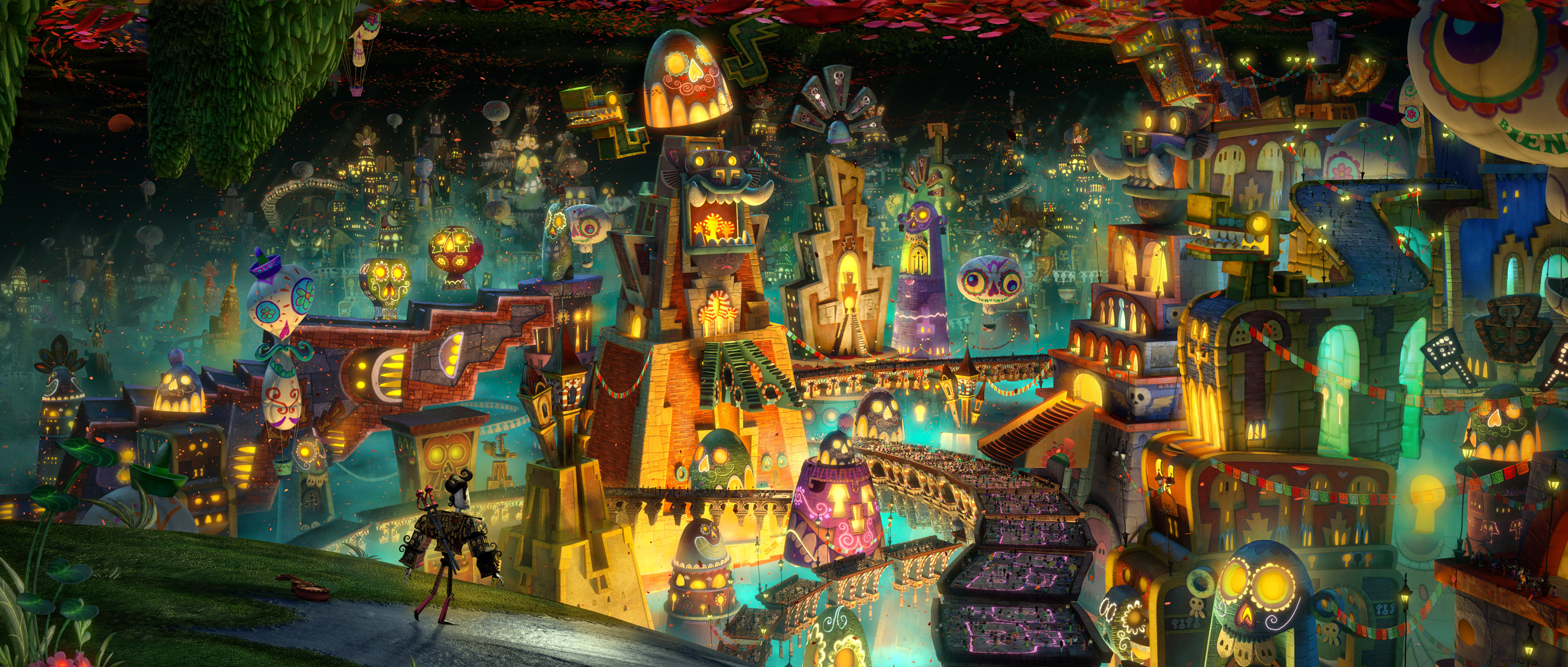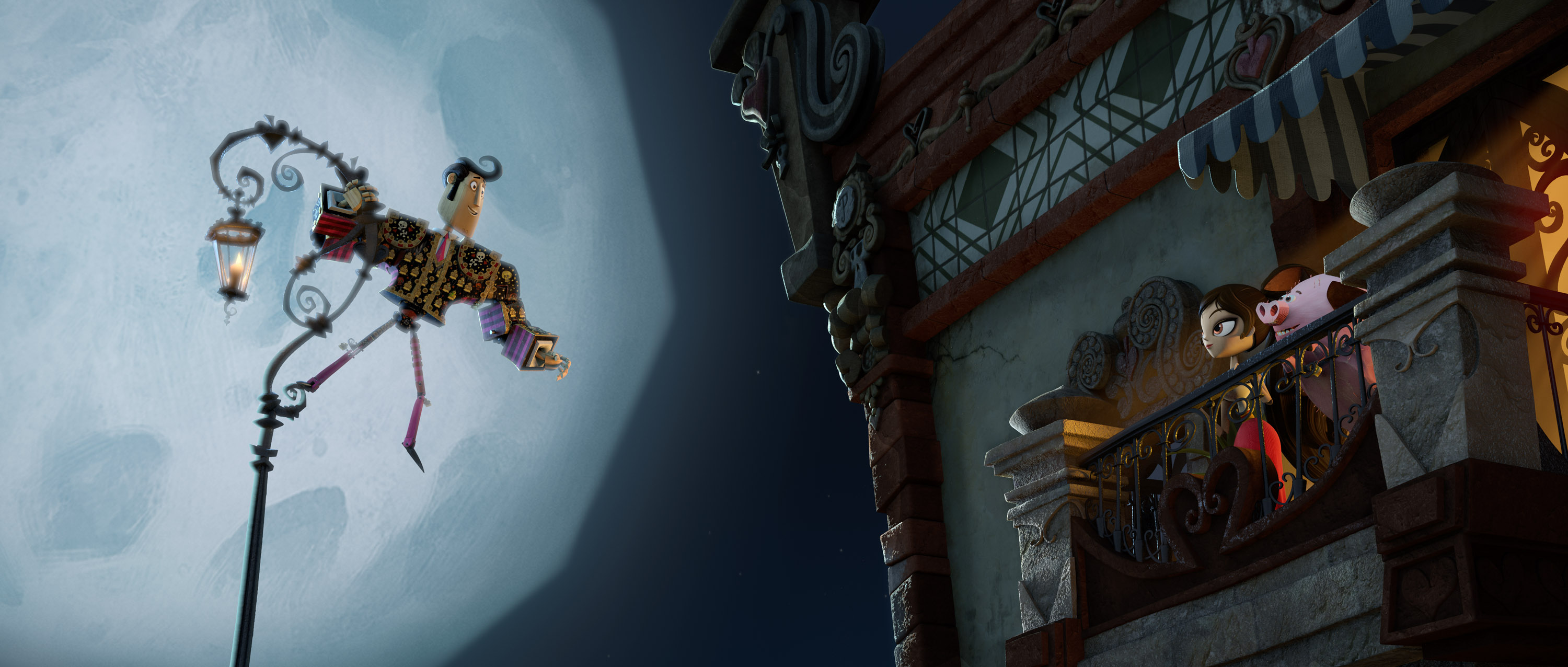We immediately knew that we wanted to go with a raytracing renderer to showcase all of the detail in the film’s unique, intricate design
Ross Moshell, Head of Technology
The Book of Life brings a spectacular vision of our world and the next to the big screen while telling a story about love, loss and redemption. Inspired by the Mexican holiday El Dia de los Muertos, or the Day of the Dead, director Jorge Gutierrez, working with Reel FX Animation studios, built a fantastic vision filled with the vivid colors, ornate detail and spiritual symbolism typical of this holiday.
The main story is told using wooden puppets that needed to maintain a hand-crafted look throughout the film. Real puppets were carved by Central American artisans as reference for the team at Reel FX. To achieve the desired look while building a rendering pipeline that could handle the visual complexity of the proposed shots, finding the right technology was critical.
“We immediately knew that we wanted to go with a raytracing renderer to showcase all of the detail in the film’s unique, intricate design” explains Ross Moshell, Head of Technology at Reel FX.
After a series of rigorous tests, the team chose Houdini’s Mantra renderer because its built-in support for the Alembic file format along with its customizability provided the team with a flexible toolset which could be used to push the limits of their pipeline.
The Alembic Advantage
The Alembic file format allowed for a seamless exchange of data between a variety of tools in the Reel FX pipeline. It made it possible to significantly reduce the amount of files required to be written to disk. Alembic handled animated geometry very efficiently, and allowed them to easily transfer data from the front end pipeline to the back end pipeline using a single geometry format.
“The key factor in choosing Houdini / Mantra for this project was the cohesiveness it would bring in tying many of our back-end departments together into the same package with a seamless exchange of data” explains Ross. “We avoided many of the typical integration issues often encountered when working across different packages, particularly between lighting and visual effects”.
Huge productivity gains also came as a result of using Mantra's native Alembic support to procedurally load their geometric assets and cameras, including geometry with changing topology, NURBS surfaces, per-point velocity and animated visibility. For certain sets in the film, they were able to push the number of assets into the tens of thousands and the number of individual shapes into the millions.
The team at Reel FX also leveraged the Alembic format to store stereo camera caches. In previous projects, they found that they typically had a wide assortment of geometry formats that needed to be supported throughout their pipeline. Alembic enabled them to consolidate their file formats into one while preserving flexibility in their tool selection.
Customizations
Working with Houdini gave Reel FX the ability to work under the hood with Houdini and customize it to meet the needs of artists. Throughout the project, they took advantage of this capability and made a number of key customizations to speed up workflow.
To start, the team leveraged the C++ and Python APIs to make customizations to Mantra and to the Houdini IFD export via SOHO. These APIs allowed them to carefully fine tune and optimize their rendering process and to reduce the burden on their lighting department.

They used the File System Helper classes to create a single plugin for Houdini and Mantra that supported cross platform path resolution. This allowed their Windows users to submit render jobs directly to a Linux render farm with no additional scene processing requirements.
In SOHO, they utilized hooks to source archived material IFDs directly into the render IFD. This allowed for complex shader networks to be excluded from lighting scenes and loaded only when necessary. They also utilized user hooks to customize eye geometry rendering, define global reflection maps, animate textures, and to create on-demand simple shaders (AOV, occlusion, shadow catchers, etc).
They also leveraged Mantra's Python filter API to customize render-time behaviors. An example of this occurred when they added support to execute a single camera render from a multi-camera IFD and to centralize error reporting.
Rendering VFX
Using Mantra to render both the visual effects and the animated geometry proved to be especially beneficial in several key areas. Reel FX’s Effects artists were able to focus their attention on producing outstanding effects, without having to divert energy to matching the lighting, displacement and fur elements that were generated procedurally from a separate render engine.
“The publishing of effects assets to lighting was very straight-forward; transportation of shaders and render settings were fast, reliable and seamless” says Ross.
Using Mantra for lighting meant that the effects could be lit by the same lights which had the same lighting direction as every other asset in the scene which resulted in highly seamless integration throughout the production. No Holdouts were necessary and motion blur was of course a perfect match.
“When it came to the extensive destruction effects in the film, we had the exact shaders and displacements available to the effects team that the lighting team would use, which allowed us to work in the same space and maintain the approved look - there was no guess work involved between the two departments” says Ross.
“Because the VEX shading language can be executed in Houdini, we were able to create a Houdini Digital Asset (HDA) that would reproduce the displacement on the actual geometry thereby preserving it for use in the fracturing. This HDA also allowed look artists to accurately calculate displacement bounds during the look publish process”.

Reel FX / Side Effects Partnership
Side Effects is known for working with their customers to help them meet their creative objectives. With The Book of Life, Reel FX and Side Effects collaborated even more closely to help take Mantra to the next level, by using it to light an entire animated production.
“We were able to work closely with Side Effects and develop tools that were driven by artist feedback and intuitive workflow throughout the production” says Ross. “Side Effects delivered on their promise to make this an engaging, collaborative process.”
Throughout production, Side Effects Software Senior Mathematician and the creator of Mantra, Mark Elendt played a key role working alongside Reel FX to help them meet their objectives.
"Any time we can observe Mantra being put to the test using complex data, we learn a great deal," says Mark. "Working closely with Reel FX gave us a unique insight into many of the production issues faced on a daily basis and as a result Mantra is a better renderer for the whole community."
A Childhood Dream Comes True
Bringing the vibrant world of El Dia de los Muertos to the big screen was a challenge well met by Reel FX. The original artwork and early concept paintings were extremely powerful and meeting the expectations of Director Jorge Gutierrez was an important milestone for the team.
“When comparing the original artwork side-by-side with the final frames of the film, Jorge would often remark that the work was looking better than what he had envisioned, which was exciting and inspirational for the artists” says Ross. “In the end, we had a great looking film that upheld Jorge's vision, and is an artistic achievement we’re all truly proud of.”
COMMENTS
Please log in to leave a comment.